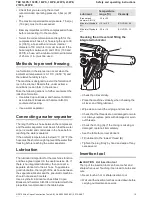
WARNING Dust and fume hazard
Dusts and/or fumes generated or dispersed when
using the machine may cause serious and permanent
respiratory disease, illness, or other bodily injury (for
example, silicosis or other irreversible lung disease
that can be fatal, cancer, birth defects, and/or skin
inflammation).
Some dusts and fumes created by drilling, breaking,
hammering, sawing, grinding and other construction
activities contain substances known to the State of
California and other authorities to cause respiratory
disease, cancer, birth defects, or other reproductive
harm. Some examples of such substances are:
●
Crystalline silica, cement, and other masonry
products.
●
Arsenic and chromium from chemically-treated
rubber.
●
Lead from lead-based paints.
Dust and fumes in the air can be invisible to the
naked eye, so do not rely on eye sight to determine
if there is dust or fumes in the air.
To reduce the risk of exposure to dust and fumes,
do all of the following:
►
Perform site-specific risk assessment. The risk
assessment should include dust and fumes
created by the use of the machine and the
potential for disturbing existing dust.
►
Use proper engineering controls to minimize the
amount of dust and fumes in the air and to
minimize build-up on equipment, surfaces,
clothing, and body parts. Examples of controls
include: exhaust ventilation and dust collection
systems, water sprays, and wet drilling. Control
dusts and fumes at the source where possible.
Make sure that controls are properly installed,
maintained and correctly used.
►
Wear, maintain and correctly use respiratory
protection as instructed by your employer and as
required by occupational health and safety
regulations. The respiratory protection must be
effective for the type of substance at issue (and if
applicable, approved by relevant governmental
authority).
►
Work in a well ventilated area.
►
If the machine has an exhaust, direct the exhaust
so as to reduce disturbance of dust in a dust filled
environment.
►
Operate and maintain the machine as
recommended in the operating and safety
instructions
►
Select, maintain and replace consumables/
working tools/ other accessory as recommended
in the operating and safety instructions. Incorrect
selection or lack of maintenance of consumables/
inserted tools/ other accessories may cause an
unnecessary increase in dust or fumes.
►
Wear washable or disposable protective clothes
at the worksite, and shower and change into clean
clothes before leaving the worksite to reduce
exposure of dust and fumes to yourself, other
persons, cars, homes, and other areas.
►
Avoid eating, drinking, and using tobacco products
in areas where there is dust or fumes.
►
Wash your hands and face thoroughly as soon as
possible upon leaving the exposure area, and
always before eating, drinking, using tobacco
products, or making contact with other persons.
►
Comply with all applicable laws and regulations,
including occupational health and safety
regulations.
►
Participate in air monitoring, medical examination
programs, and health and safety training programs
provided by your employer or trade organizations
and in accordance with occupational health and
safety regulations and recommendations. Consult
with physicians experienced with relevant
occupational medicine.
►
Work with your employer and trade organization
to reduce dust and fume exposure at the worksite
and to reduce the risks. Effective health and safety
programs, policies and procedures for protecting
workers and others against harmful exposure to
dust and fumes should be established and
implemented based on advice from health and
safety experts. Consult with experts.
►
Residues of hazardous substances on the
machine can be a risk. Before undertaking any
maintenance on the machine clean it thoroughly.
WARNING Projectiles
Failure of the work piece, of accessories, or even of
the machine itself may generate high velocity
projectiles. During operating, splinters or other
particles from the working material may become
projectiles and cause personal injury by striking the
operator or other persons. To reduce these risk:
►
Use approved personal protective equipment and
safety helmet, including impact resistant eye
protection with side protection.
►
Make sure that no unauthorised persons trespass
into the working zone.
►
Keep the workplace free from foreign objects.
►
Ensure that the work piece is securely fixed.
© 2012 Atlas Copco Construction Tools AB | No. 9800 0683 82f | 2012-08-07
Original instructions
10
TEX 140PS, 150PE, 180PS, 190PE, 220PS, 230PE,
270PS, 280PE
Safety and operating instructions





































